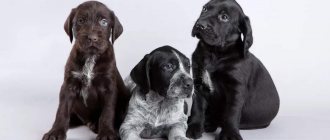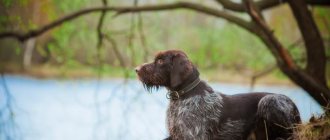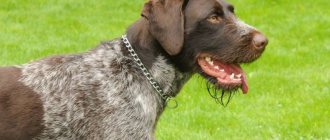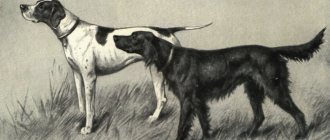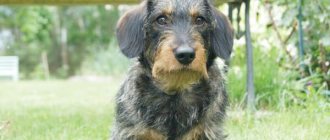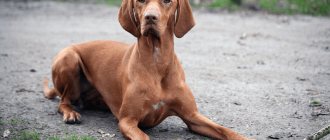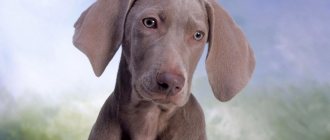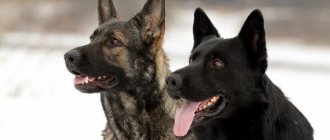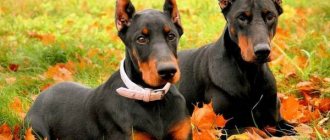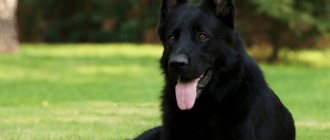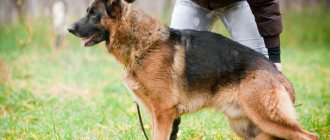The Drathaar is a breed of hunting pointing dog bred in the mid-19th century in Germany and then spreading first across Europe and then throughout the world. Currently, the Drahthaar, along with the Shorthaired Pointer, is the most popular and most common breed of hunting dog in our country. The drathaar's closest relatives are the shorthaired pointer and the langhaar. Let's tell you more about this wonderful breed of dog.
Brief history of origin
The homeland of the Drathaar, or German hunting dog, is Germany. It was there that, at the end of the 19th century, they decided to breed a national breed that would feel equally good during rifle hunting in the forest, in the field, in the swamp. Baron Sigismund von Zedlitz took up the development of the idea. The best short- and coarse-haired dogs were selected for selection: the French griffon Korthals, the German pointer poodle (the result of crossing an obedient and intelligent poodle with an English pointer), Stichelhaar, and shorthaired pointer.
As a result, the famous German Wirehaired Pointer appeared - a balanced, assertive, loyal, easy-to-train and very hard-working dog. It is used equally well when hunting various birds and some animals, and therefore quickly established itself well not only in its homeland, but also in other countries.
Interesting! In May 1902, the owners and admirers of the new breed founded the Deutsch-Drahthaar organization in Germany. And in the first half of the 20s of the last century, the German wirehaired pointer was recognized by the International Canine Federation.
Price
If you are a true connoisseur and fan of hunting, then you should go to his homeland, that is, to Germany, for a “professional” four-legged friend. Fortunately, there are many drathaar nurseries there. Experts will help you make a choice and tell you about methods of feeding, training and keeping the animal.
The price of a drathaar brought from Germany is from 500 euros. The future owner must also take into account the costs of transporting the animal or traveling to pick it up. This purchase can cost at least 1000 euros.
For those who love hunting, but do not plan to spend a huge amount of money on an assistance dog, much less go to another country for one, you can use the services of one of 3 Moscow kennels. Thoroughbred representatives of the breed are sold there from 25 to 40 thousand rubles.
Interesting Facts
Currently, Drahthaars are popular among hunters in many countries around the world, and therefore interest in this breed is steadily growing.
A few points that may make someone look at the German Wirehaired Pointer in a new way:
- In Germany, 40% of all hunting dogs are Drahthaars. Here the pups are taught to hunt several types of game. For comparison: in Russia, dog handlers usually train representatives of this breed for one type of hunting. The reason is that it’s easier for the dog to understand what they want from it.
- “Collective intelligence” - this is how one can say about the relationship between many hunters and their loyal German wire-haired cops. After several seasons, a strong spiritual connection is established between the drathaar and the person: they seem to understand each other perfectly. If it is not possible to achieve understanding with the pet, it begins to hunt on its own.
- The name of the Drathaar breed seems strange to many. In fact, it indicates the main characteristic of these dogs: translated from German, draht means “wire”, haar means “hair”. The coat of these dogs is actually so tough that it practically does not get wet. This allows the animal to withstand frosts down to -30°. Drathaar is one of those dogs about which you can say: the more time the dog spends outside and in movement, the healthier it feels. Moreover, cold is preferable to drathaar than heat.
- Although German Wirehaired Pointers are classified as hunting dogs, recently they are often used in their work by Emergency Situations Ministry employees.
- The modern Stichelhaar is very similar in appearance to the drathaar.
Innate qualities
This breed is considered a hunting breed. By nature, he is endowed with the ability to follow the scent, and can work in the field with a stand or to serve game, which makes hunting with a drathaar fruitful.
Thanks to its skills, the breed is often used to work in the Ministry of Emergency Situations, at customs, as well as in circus performances.
Please note that the dog must work in tandem with the owner, otherwise he will begin to hunt on his own, refusing to obey.
Breed description, standards, appearance
Drathaar is a memorable dog. The first thing that catches your eye is her mustache and goatee - details that cannot be ignored when describing her. To some extent, any representative of this breed resembles an old man, thoughtful and sad. However, first impressions are deceiving.
If you look more closely at the face of this unusual dog, you will notice an inquisitive look and an extraordinary mind. And in speed, the Drathaar is inferior to few others - very often at competitions among hunting dogs, it is the German wire-haired pointers that take first prizes.
Provided, of course, that they fully comply with the characteristics of the breed in the FCI standard.
Size and constitution
The purebred drathaar looks noble. To a large extent, this is facilitated by the correct proportions of his body: the length of the body can exceed the height at the withers by no more than 3 cm.
Dog sizes:
- height at the withers (for females and males, respectively) – 57–64 and 61–68 cm;
- weight – on average 23–32 kg.
Drathaar Standards:
- The head is proportional to the body, the transition to the muzzle is clearly defined. The developed brow ridges are striking.
- The drathaar's eyes are dark, with pigmented eyelids. They don't stand out much.
- The muzzle is long and wide. Looks pretty sturdy. She is decorated with a mustache and beard.
- The nose is slightly humpbacked with a lobe matching the color of the nose with well-opened nostrils.
- The drathaar's jaws are powerful, with large teeth (an adult dog has 42 of them). Scissor bite. The lips also have noticeable pigment, are thick, and do not droop.
- The ears are medium in size, set high, drooping.
- The head “sits” on a muscular neck of medium length. There is no suspension.
- The drathaar's body has well-defined withers and a strong, muscular back. Wide croup, pelvis and chest. The latter is well developed, the sternum goes far back. The belly is tucked in, without dewlap.
- The legs are long and straight, set parallel. The shoulder blades, humeri, and thighs are quite muscular. The paws are oval-round, resembling a lump. The pigmented pads are strong and tough.
- The tail of medium thickness is raised or set horizontally in a saber shape. German wirehaired pointers, who are guaranteed to participate in the hunt, will have it docked (unless prohibited by the laws of the country).
Interesting! Drathaar is energetic, moves expansively and at the same time smoothly, holds himself confidently - this can be seen even in the photo. He always runs with a good reach and push, while the dog raises his neck and head.
Color and coat type
The skin, which fits tightly to the body, is covered with thick hair. In structure, it really resembles a wire about 2–4 cm long. Moreover, on the stomach, on the lower part of the chest and legs, on the head and ears, the hairs are shorter and thicker, but not soft. When describing the Drahthaar breed, special attention is paid to this fact, since it is the rigidity and thickness of the coat that distinguishes this German pointer from other smooth-haired breeds.
Under the fur there is an equally thick undercoat. Together they protect the dog’s body from moisture, thorns, and severe frosts. Therefore, the drathaar feels comfortable in any environment and in any climatic conditions. This is especially appreciated by hunters from places with harsh climates.
Typically, drathaars have a speckled (gray-haired) shirt, often with spots. Options for these colors:
- black;
- brown.
Also, German Wirehaired Pointers can be:
- sparsely speckled;
- brown without specks or spots, sometimes with a white mark on the chest.
Important! Other colors of the drathaar are not allowed by the standard.
Health and life expectancy
Drathaars generally live between 12 and 16 years. Moreover, this period often depends on the quality of care and conditions created for the dog. Basically, German wirehaired pointers suffer from the following diseases:
- hip dysplasia - due to weight;
- hypothyroidism (impaired pancreatic function);
- diabetes;
- licked granuloma;
- eye problems (cataracts);
- otitis.
Pneumonia can also develop in a drathaar if the dog spends a long time in water during the cold season.
Reproductive function
A female dog's first heat can occur between 6 and 12 months of age. Puberty develops around the age of one and a half years. It is at this time that it is best to carry out the first mating. Pregnancy proceeds without pathologies. Childbirth is usually spontaneous. The average number of offspring in a litter is 10. German cops are good mothers. Sometimes, in the first days after childbirth, due to hormonal imbalance, behavioral disturbances occur. Bitches do not accept puppies and express aggression towards them. Typically, such disorders go away on their own, without external intervention.
Character and behavior
Drathaars are primarily hunters, and this must be taken into account if there is a desire to adopt a puppy of this breed. Already in childhood, the dog will be very active. As you grow older, your passion for long-term physical activity will increase.
You won't be able to lie on the couch for hours with a drathaar: the pet can destroy everything around you if you don't take it for a walk in time. After all, the German Wirehaired Cop has more than enough energy and needs to be given an outlet.
But a representative of this breed has many advantages:
- drathaar is equally attached to all family members;
- the pet will become a faithful friend to its owner and will never betray him;
- the dog practically does not show aggression towards people, although it treats strangers with suspicion and mistrust;
- the drathaar is very efficient at work and approaches all assignments responsibly;
- can make decisions independently, is brave, and therefore becomes an excellent watchman and even a bodyguard.
One of the disadvantages is the desire for dominance - it applies to both people and other animals. Therefore, when communicating with a pet, you should never show weakness: the drathaar will immediately take advantage of the moment and try to subjugate its owner to itself. Otherwise, the German Wirehaired Pointer is a fairly docile and obedient dog.
Breed and other animals
Drathaars are tolerant of others, but very jealous. This explains why other pets that receive a lot of attention from the owner often cause dissatisfaction in the dog. And it is certainly unlikely that two male drathaars will coexist in the same territory. For this reason, it is not advisable to adopt a puppy of this breed if there are already dogs in the house.
In most cases, drathaars behave aggressively towards strangers and animals on the street. Any walk with a pet can result in him fearlessly throwing himself at a dog, and a fairly large one at that. And you need to be prepared for this. As well as the fact that any small animal (rats, squirrels, rabbits) easily becomes prey for the German wire-haired pointer.
Breed and children
Drathaars are friendly dogs. This is especially noticeable in their attitude towards children. Dog breeders, in whose home representatives of this breed live, note that the drathaar is capable of becoming a real nanny for a child. Despite its impressive size, the dog can play with children for a long time. The Drathaar especially likes active activities (catching up, running after a bicycle), which is explained by the characteristics of the breed. Although sitting for a long time next to the baby is also not uncommon - this is how the dog protects the peace of the little family member.
Nickname
The next step after purchase is to decide on the name of your four-legged friend. Each litter in the nursery has its own letter with which the nickname should begin. Purebloods usually have two names. One is the pedigree recorded in documents. It may be reminiscent of kinship with titled ancestors. The other is homemade, simple. The second name can be either a derivative of the first or different from it, arbitrary. It can talk about the noble German origin, behavioral characteristics, or the hot temperament of the student. The best way to name your pet is to observe him and his behavior for several days. Sooner or later, some dominant or entertaining character trait will help you make your choice.
The nickname should not remind the dog of any command, and should not coincide with the names of family members, friends or frequent guests at home. It should be liked by everyone who lives next to the dog, have many diminutive forms, and not become boring over time due to repeated use.
Not everyone can own and raise such a dog. This breed is for people who love hunting and an active lifestyle. A person with a phlegmatic character should prefer another pet.
How to choose a pet
To buy a real drathaar, it is advisable to contact a specialized nursery. You need to talk to specialists in advance and find out what qualities a Drahthaar puppy should have. This is especially important for those dog breeders who plan to exhibit their dog or take it hunting.
Here are the most important points:
- Experts recommend adopting a puppy at the age of 3 months. By this time, the baby should have pronounced eyebrows, a mustache and a goatee - these features are possessed by the drathaar and the stichelhaar. If they are not there, it is better to refuse the purchase - most likely, they are selling a mestizo under the guise of a drathaar.
- A strong body with correct proportions and thick legs. Another sign of a real German Wirehaired Pointer.
- You should not trust only words that the puppy is purebred. You need to meet his parents. The ideal option is that they are holders of at least two diplomas: in field and swamp game.
- Since the Drahthaar naturally strives for dominance, it is important to take a closer look at the puppy’s behavior. In a small flock, a good hunter will also strive for leadership. But signs of cowardice or aggression towards humans do not at all suit a representative of this breed.
- It is worth paying attention to the gender of the puppy. The female is more suitable for novice hunters and dog breeders: females are more accommodating and easier to train. But experienced dog handlers and hunters can deal better with stubborn and freedom-loving males.
In addition, it is necessary to pay attention to the vices that will definitely not allow the use of the drathaar for breeding or participation in exhibitions (if there is such a purpose):
- malocclusion;
- eye problems: inversion of the lower (entropy) and inversion of the upper (ectropia) eyelid, different iris;
- tail with kinks;
- atypical pigmentation.
The puppy must be healthy, active, and sociable.
Application
Drathaar is a hunting dog with an excellent sense of smell and acute hearing. With proper upbringing, your pet can turn out to be a first-class watchman or security guard.
Modern German cops take part in competitions in:
- ski joring;
- bike joring;
- dryland.
Drathaars are often recruited to serve in the Ministry of Emergency Situations.
Puppy care
From the first moment a drathaar appears in the house, you need to create the necessary conditions for a comfortable life: buy bowls for food and water, toys and other accessories in advance. Although adult German Wirehaired Pointers tolerate frost well, babies should not be left in the cold.
Important! It is very important to start socializing your puppy from an early age. Classes should be short, in the form of a game. Most of the time the drathaar must be moving. The high activity of a dog of this breed in childhood is a guarantee that it will develop correctly. Moreover, the baby should spend a considerable part of his time in nature.
Particular attention should be paid to the nutrition of the drathaar puppy - because how it will grow depends on it. At an early age, it is advisable to give preference to natural products and special nutritional supplements.
Your baby's diet must include:
- lean minced meat with a minimum amount of veins and bones;
- low-fat soups;
- porridge – it is better to give preference to buckwheat with butter;
- milk, as well as cottage cheese, kefir and other fermented milk products - they have a positive effect on the formation of bones and teeth;
- boiled eggs;
- vegetable and fruit purees.
For small puppies, the daily intake is divided into 5–6 parts. As the dog gets older, the number of feedings is gradually reduced - a one-year-old drathaar should eat twice a day.
In order for the pet's undercoat to form correctly and the coat to grow hard and of the desired length, the puppy must be brushed regularly. To remove soft hair from the head, it is advisable to trim it.
The drathaar needs to be given the necessary vaccinations in a timely manner - their schedule is drawn up by a veterinarian. Caring for a German Wirehaired Pointer is the same at different ages.
Mating
Drathaars are bred after full puberty - at 20-24 months. Ideal days are from 11 to 15 from the start of estrus. Wirehaired Pointers are introduced on neutral territory, after which the bitch is brought to the male.
Photo from the nursery https://animavenator.com.ua
Mating is carried out in a free manner. After 1-2 days it is better to do a control mating. Pregnancy lasts about 63 days, and childbirth is usually easy. Drathaar brings 5-8 puppies in a litter.
Care and maintenance
The wire-haired German Pointer does not require any special skills. Caring for her is quite simple and includes a number of procedures common to most dogs. The regularity of these depends on the dog’s lifestyle.
Hygiene procedures
The peculiarity of the coat of drathaars is that the hairs are not very long, but rather hard. They practically do not get tangled, so combing can be done once a week. It is better to do this with a brush with metal teeth, but it is important to ensure that you do not accidentally harm the skin.
Typically, the number of coat brushings increases during the shedding period. German Wirehaired Pointers shed twice a year. However, if dogs live in an apartment, fur can fall off almost all year round, and this should not come as a surprise.
Important! The drathaara is also bathed infrequently - 2-3 times a year with shampoo for coarse fur. If you do this more often, the structure of the coat will change, and the dog will lose one of its main qualities.
Other procedures:
- Eye wash. To do this, you can use a weak chamomile decoction and a cotton pad or soft cloth.
- Examination of the ears. Sulfur should not accumulate in them - a small amount of it can be easily removed with a cotton pad. The smell and leaking liquid are unacceptable - if they appear, you should visit a veterinarian. Since the drathaar's ears are drooping, they need to be ventilated regularly: lift the ear flap and lightly wave it.
- Caring for mustache and beard. This is a weak point on the face of the German Wirehaired Pointer, as food constantly remains in the long hairs. There are two options: wipe the drathaar's face after every meal and trim the hair a little.
- The drathaar's claws usually wear down on their own if the animal moves a lot outside. If this does not happen, they need to be trimmed as they grow - about once a month.
- After walking and hunting, you need to inspect the pads on your paws. Scratches, cuts, and splinters often appear on them. Often cracks are a sign of a lack of fat in the drathaar’s body. In such cases, it is necessary to lubricate the pads with nourishing cream or vegetable oil. A teaspoon of the latter can be added to food.
With such care, the drathaar will always feel great and look its best.
Feeding
Adult German cops are not very picky when it comes to food - you can feed the drathaar with both dry food and natural food. The first option is preferred by dog owners in the West, especially in Germany. In Russia, dog handlers and hunters more often give their pets natural products. There is a third option - alternate between dry and natural food. However, experts do not take this idea very well.
An adult drathaar is fed twice a day. Moreover, a dog that lives in an outdoor enclosure will need more food.
Industrial feed
This type of feeding is often chosen by owners who do not have the time or desire to constantly cook - after all, the dog needs special nutrition, and it cannot be fed with leftovers from the human table. The advantage of this method is that the pet is guaranteed to receive the necessary complex of vitamins, minerals and other beneficial substances. Manufacturers pay special attention to their ratio.
From ready-made products, you need to choose premium and super food. They must be designed for large active dogs and contain at least 30% protein products. The amount of product is selected taking into account the weight of the drathaar and the recommendations on the packaging. A prerequisite is to provide your pet with constant access to clean water.
Natural feeding
The main disadvantage of natural feeding of the drathaar is the need to monitor the ratio of different foods in the pet’s diet:
- Every day your dog needs raw or cooked meat products - their amount should be about 2/3 of the total food. German wirehaired pointers happily eat trimmings and offal, the main thing is that they are not fatty. You cannot give the drathaar pieces of meat with long bones. Minced meat is also undesirable.
- Porridges made from rice, buckwheat, or oatmeal are suitable as a side dish. Millet and pearl barley are contraindicated for these dogs.
- Vegetables (except potatoes, legumes, peas) will provide your pet with the necessary vitamins and fiber. They can be given to the drathaar raw or cooked.
- German cops will not refuse to eat fruits, such as apples or pears.
- Every week you need to feed the drathaar chicken eggs.
But the amount of dairy products for adult dogs should be limited.
Also, with natural feeding, you will need to select a complex vitamin and mineral supplement. It is usually selected by a veterinarian, taking into account the pet’s lifestyle and daily diet.
Walking and hunting
Drathaar is a hunting dog, and therefore it will not lie for hours and wait for its owner to take it for a walk for half an hour or an hour. You need to walk a lot with a German cop. Two times for 2-3 hours is the minimum for such a pet. Moreover, walks should be active: running 2–3 kilometers a day is a common occurrence for the drathaar. Therefore, the ideal option for a German Wirehaired Pointer is to live in a private house with a large yard.
In this case, the dog will be more comfortable in an outdoor enclosure. In an insulated home, the drathaar can easily tolerate fairly severe frosts, but in case of severe cold it is still better to take the animal indoors.
The drathaar feels best when hunting: the ability to track down prey is in the blood of this breed. He will happily run for hours across fields, wade through thorny thickets, and rush into a pond after a duck or goose. If these dogs live in a private house and have the opportunity to run around the neighborhood, they even catch mice and rats, which they then bring to their owners.
Important! With a drathaar you can hunt waterfowl and pheasants, hares and other small animals. Some dogs are successful at tracking roe deer or wild boar, but in this case they are a little lacking in agility and springiness. Therefore, it is undesirable to take a German wirehaired pointer for such a large animal.
Training and education
Drahthaars are easy to train: much of what other dogs memorize within 2-3 months, they learn in a few days. The only hindrance can be the stubbornness that they sometimes display. The reason is screaming and cruelty (not to be confused with harshness) on the part of a person. But the drathaar responds to praise immediately, as well as to encouragement. Therefore, when training with a German wirehaired pointer, you need to show patience and tact, and treat it more often.
You need to raise a pet from the first days of its arrival in the house. It is important already in childhood to accustom the drathaar to the discipline and perseverance that will be needed on the hunt. Moreover, the pet must follow the owner’s orders in any environment: at home, on the street among people, in the field.
The owner can teach the pet the basic commands independently. If in the future you plan to exhibit the drathaar or regularly go hunting with it, it is better to entrust the training to a specialist. He will teach the dog what it must do:
- find prey and notify the hunter about this with a “stand” pose;
- barking to distract potential prey;
- bring the hunter to the shot animal, if it is large;
- deliver prey that has fallen into a hard-to-reach place: into a swamp, into thorny thickets.
Drathaar must show restraint: wait for a command from a person, and not run headlong after prey as soon as he sees it. But the main thing is that the German Wirehaired Pointer should not be afraid of shots. Her task is to carry out her duties both before and after the shot.
Drathaar's Health
The weak points of the drathaar are the intestines, bones and skin. Some representatives of the breed suffer from hip or elbow dysplasia.
If an animal's bones develop abnormally, over time this can cause lameness, arthritis, and pain in the paws.
- Intestinal volvulus can happen if a hearty lunch with plenty of drink is suddenly replaced by active training and vigorous walks. Symptoms: Bloated stomach, urge to vomit, depression. The problem is typical for older animals. Without medical attention, the disease can be fatal.
- Skin diseases are most often associated with allergies. The cause may be diet, insect bites, pollen, or plant sap. Symptoms: itching, swelling, skin rash, hair loss, sneezing. Allergies are treated by relieving symptoms until it is determined which allergen is causing the unpleasant condition.
Pros and cons of the breed
The Drathaar dog breed has many advantages. But we must not forget that the animal is quite demanding in terms of living conditions.
Table 1. Pros and cons of this breed.
| pros | Minuses |
| Drathaars are friendly and treat all family members equally well, including children. | Drathaars are very active dogs, and therefore you need to walk them at least 2 times a day for 2-3 hours |
| Adapt well to new conditions, hardy | They strive for dominance and can be aggressive towards other pets. |
| Low maintenance | Dogs need to be supervised as they are very curious. |
| They are highly efficient and can be hunters, watchmen and even shepherds | Exhibition and professional hunting require special training, which is not cheap. |
Thus, it is advisable to get a German Wirehaired Pointer for active people who are ready to spend several hours every day with the dog. The best option for a pet is a private house with a large plot, especially if you can run around the neighborhood a lot.
Important! The drathaar (shtihelhaar) is definitely not suitable for those who dream of an obedient pet who spends most of the time next to them on the sofa or on their own lounger.
Nutrition
The diet should include only high-quality products.
Those who are really interested in the question of where to buy a Drahthaar dog will be interested to know that there are several types of feeding:
- Only natural products;
- Dry food only;
- Mixed nutrition (natural food + food).
It is very important not to mix natural and dry food in one feeding, which is fraught with health problems such as volvulus, and much more.
The need for regular medical examination
The more attention a person pays to the health of a pet, the less chance the latter has of getting sick. Due to increased physical activity, the animal runs the risk of various types of damage. An unsuccessful jump, a fall, or a muscle strain are just a few of the medical problems. Those who have experienced this know how much the entire list of medications necessary for rehabilitation therapy costs.
In second place in frequency are pathologies caused by an incorrectly formed diet. On the one hand, people know that an active dog requires a lot of energy. On the other hand, the animal’s nutrition sometimes leaves much to be desired. It is imperative to visit a veterinarian. The doctor will conduct an examination and give specific recommendations to the owners.
Veterinarians have compiled a list of the most common medical pathologies of the breed:
- diabetes mellitus – formed against the background of a genetic predisposition or as a result of an incorrectly selected diet;
- otitis and other pathologies of the auricle;
- violation of the integrity of the hip joint;
- volvulus;
- increased gas formation;
- pathological changes in the structure of the eyelid;
- melanoma in various forms;
- aortic stenosis;
- complete or partial rupture of ligaments;
- cataract;
- decreased visual acuity;
- malignant and benign oncological neoplasms;
- atrophy of the organs of vision and hearing;
- raw eczema.
As can be seen from the above list, the animal is predisposed to many dangerous diseases. In this regard, a person should regularly bring their pet to the veterinarian's office for preventive purposes . Only in this case can pathologies be diagnosed at an early stage. Thanks to the achievements of modern veterinary medicine, most diseases can be cured at an early stage.
Disease susceptibility
Drathaars are predisposed to dysplasia of the elbow and hip joints, rupture of the anterior cruciate ligament, Wobbler syndrome (a neurological syndrome associated with a genetically determined disorder in the structure of the cervical vertebrae), and injuries to the musculoskeletal system.
Drathaars can be susceptible to inflammatory skin diseases, pododermatitis, otitis, and eczema. They are prone to developing sensitive digestion for no particular reason and, like many other large breeds, torsion.
Timely contact with a veterinarian, as well as proper care and maintenance of the drathaar will preserve the dog’s health for many years and help avoid the development of many diseases.
Feeding recommendations
Drathaars belong to a group of large breeds of dogs with an athletic build. Such dogs spend a lot of energy because they lead an active lifestyle. Large calorie losses must be replaced by increased levels of readily available energy sources in the feed. These conditions are met by complete dry food for dogs of large breeds with an athletic build: Purina® PRO PLAN® OPTISTART® Large Puppy Athletic for puppies and Purina® PRO PLAN® Large Adult Athletic with the OPTIBALANCE® complex for adult dogs.
If your Drahthaar has special dietary needs, such as sensitive skin or digestive issues, PRO PLAN® has specific diets designed to provide nutritional support to the skin, coat and digestive system.
The educational process takes time
You need to know that the characteristics of the breed include a point about the need to follow a certain sequence of actions when it comes to the issue of training. Any deviations from the recommendations of dog handlers will lead to sad results. Nature has determined that the black dog is stubborn. Any attempts to apply pressure by force of one’s own will will end in vain.
That is why, when training an animal, you need to rely on cunning. The minimum duration of training is 4-5 months. The specified time period is quite enough to transfer the necessary skills to the animal and consolidate them. Training is carried out only by the owner, otherwise an important psychological connection will not be formed.
It is worth remembering that a hunting dog is strongly attached to its owner. If you decide to use the services of a professional trainer, then the presence of the owner is mandatory.
The dog must remember who is in charge. At the same time, the owner himself needs to learn to feel the animal. Only in this case will the person and the pet coexist harmoniously.
From a psychological point of view, during the preparation stage, the dog is taught to trust not only the owner, but also those around him. At the same time, dog handlers urge not to go too far. The main task is to deprive the animal of the pathological fear that everyone around is planning to harm it. According to dog handlers, here lies the main problem in the interaction between people and dogs. Looking at its size, many are scared. It seems to them that such a formidable appearance hides a similar disposition.
